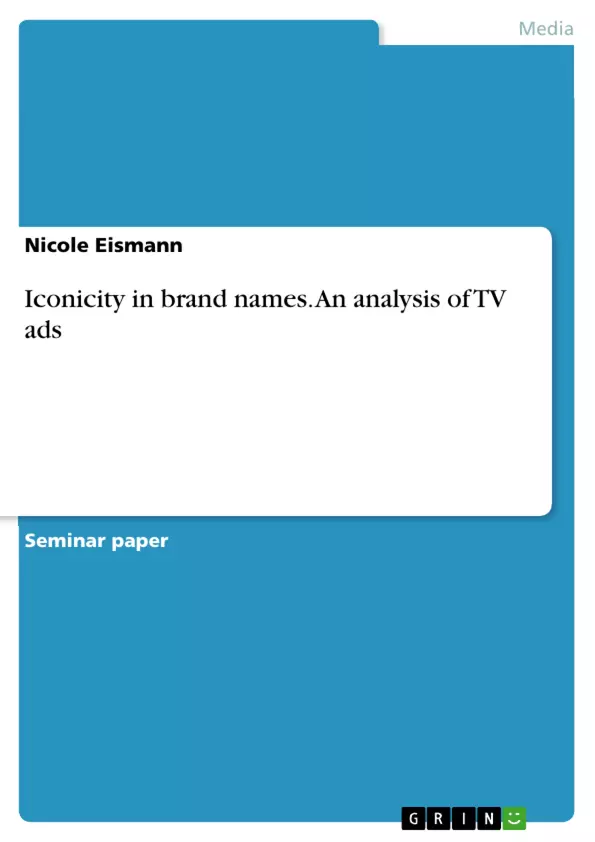Do brand names have an iconic function, or are they rather arbitrary, just like Saussure claimed concerning linguistic signs in general? And if they have an iconic function, does the iconicity of brand names serve its purpose, i.e. do the icons transport the connotation they are supposed to? These questions are going to be answered in this paper with the single focus on phonetic phenomena.
“Linguistics and semiotics still labor under the shadow of Saussure (1916), even though throughout the 20th century there have been repeated demonstrations that arbitrariness is quite limited”. With this statement, Waugh (1992:7) gets to the heart of a problem which is by far not new but still current. While Saussure worked out the relationship between 'signified' and 'signifier', i.e. between an object and its sign, as arbitrary and therefore totally insignificant, no small number of scientists back the assumption that there are indeed certain meanings behind morphological and phonetic symbols, what builds the base for the entire study of iconicity. Iconicity itself is defined as the connection between an object and its linguistic sign, which is called an 'icon' or 'iconic sign' if the relationship between this object and its sign “depends on similarity […] or on some relation analogous to similarity” (Hilpinen 2012:267). An icon might include a proper description of the object and therefore transport a certain denotation for exactly this object. This paper, however, makes brands and their iconic (or non-iconic) names a subject of discussion. Brand names are, for certain reasons, by no means denotations, i.e. they do not 'describe' the object, but are supposed to transport a meaning which is of importance for the consumer, and therefore supposed to trigger special connotations with the brand. In other words, the connection between brand name and connotation is important rather than the connection between brand name and product.
Inhaltsverzeichnis (Table of Contents)
- Introduction
- Iconicity in brand names a literature review
- Special phonetic patterns and what they express
- The role of the recipient
- Methodology
- Results
- Findings for Spanish-Italian, French and Latin patterns
- Findings for clusters
- Findings for single phonemes
- Discussion
- Conclusion
Zielsetzung und Themenschwerpunkte (Objectives and Key Themes)
This paper explores the concept of iconicity in brand names, examining whether phonetic patterns in brand names contribute to their meaning and influence consumer perception. It investigates how these patterns, including specific vowel and consonant combinations, clusters, and lexeme patterns, trigger connotations associated with the brand.
- The role of iconicity in brand naming and its potential to convey meaning beyond denotation.
- The influence of phonetic patterns on consumer perception and brand associations.
- The application of sound symbolism in brand names, specifically focusing on “synaesthetic sound symbolism”.
- The analysis of various phonetic patterns, including French, Spanish-Italian, Latin patterns, and specific phoneme clusters.
- The connection between phonetic patterns and connotations related to size, quality, and other abstract concepts.
Zusammenfassung der Kapitel (Chapter Summaries)
The introduction delves into the concept of iconicity in linguistics and its relevance to brand names. It establishes the research question: do brand names possess an iconic function, and if so, do these icons effectively convey the intended connotations? The paper focuses on phonetic phenomena and outlines its structure, including a literature review, methodology, results, discussion, and conclusion.
Chapter 2 provides a literature review, examining existing research on iconic brand names. It explores the use of special phonetic patterns, known as “synaesthetic sound symbolism,” and how these patterns can evoke non-acoustic, abstract concepts. The chapter specifically discusses the French, Spanish-Italian, and Latin patterns, along with common clusters like /gl/ and /kr/, and their associated connotations.
Chapter 3 outlines the methodology employed in the research, which involves analyzing brand names and TV ads. The chapter also describes the evaluation of data collected from a questionnaire.
Chapter 4 presents the findings of the research, focusing on the results for various phonetic patterns, clusters, and single phonemes.
Schlüsselwörter (Keywords)
Iconicity, brand names, sound symbolism, synaesthetic sound symbolism, phonetic patterns, consumer perception, brand associations, French pattern, Spanish-Italian pattern, Latin pattern, clusters, single phonemes, connotations.
- Quote paper
- BA Nicole Eismann (Author), 2013, Iconicity in brand names. An analysis of TV ads, Munich, GRIN Verlag, https://www.grin.com/document/319146



